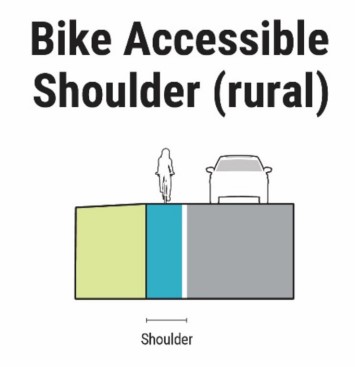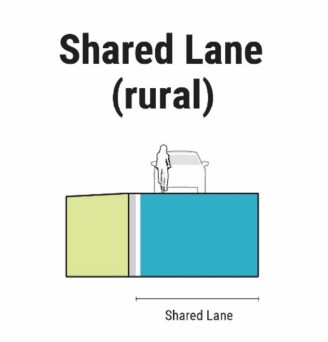18.4.8 Rural Bikeway Types
The following bikeway types are the most common in rural areas. Other bikeway types may be considered where a higher degree of comfort is desired for bicycling following the guidance of
. For example, On the
Texas Bicycle Tourism Trail Example Network
, other bikeway types, such as a buffered bike lane, may be desirable in place of a shoulder.
Figure 18-28: Example Photo of Rural Shared Use Path
18.4.8.1 Shared Use Path
A Shared Use Path adjacent to roadway (sidepath) with separation from the roadway is an option on rural facilities. An additional option is a Shared Use Path on an independent alignment. While it is recognized that these types of facilities are not usually feasible on most rural projects, consideration should be given to using them on the
Texas Bicycle Tourism Trails Example Network
and rural roadways with ADT over 6000. If they are used, see
and the
for further design guidance.
Figure 18-29: Example Rural Bike Accessible Shoulder Schematic
18.4.8.2 Bike Accessible Shoulders
Bike accessible shoulders in rural areas function the same as bike accessible shoulders in urban areas with the exception that the roadway will generally not have curb at the edge. If they are used, see
, and the
for further design guidance.
18.4.8.3 Shared Lanes (wide outside lanes)
Shared lanes (wide outside lane) are lanes that allow compatibility of operation for both motorized vehicles and bicycles. Since bicycles may be operated on all roadways except where prohibited by statute or regulations, shared lanes without markings already exist in many rural settings.

Figure 18-30: Example Rural Shared Lane Schematic
Note that although marked shared lanes are allowed in the
for certain conditions, TxDOT as a general policy does not recommend marked shared lanes for TxDOT roadways due to the higher speed nature of TxDOT roadways as compared to local jurisdictions. Also, shared lane markings alone do not provide any additional safety for bicyclists and do not substantiate a dedicated bicycle facility. In a rural applications, shared wide outside lanes should only be used in locations with low volumes (1,000 ADT or lower) and speeds of 45 mph or less.